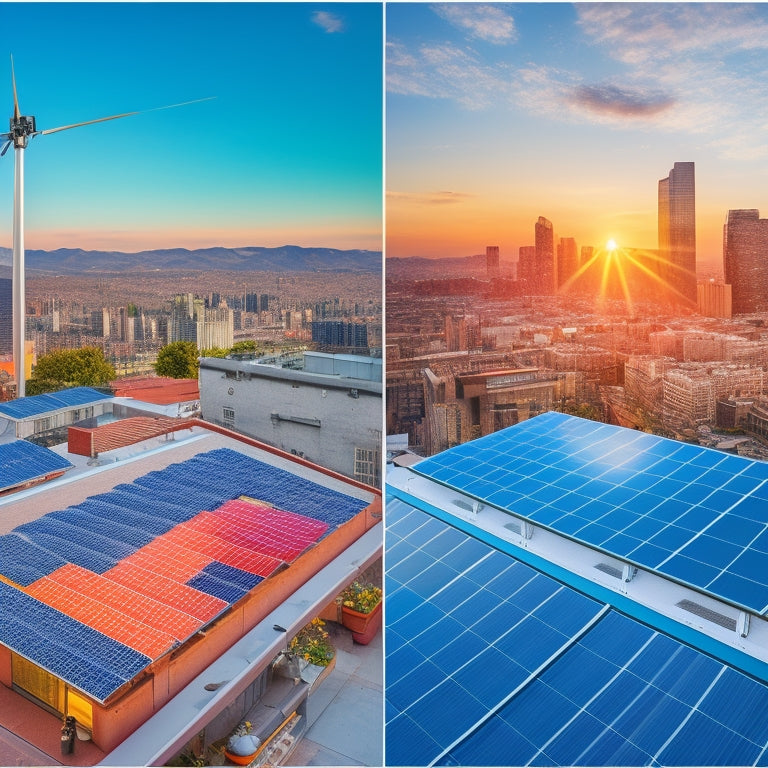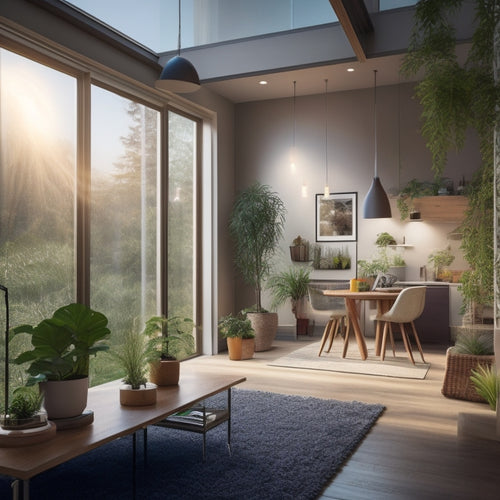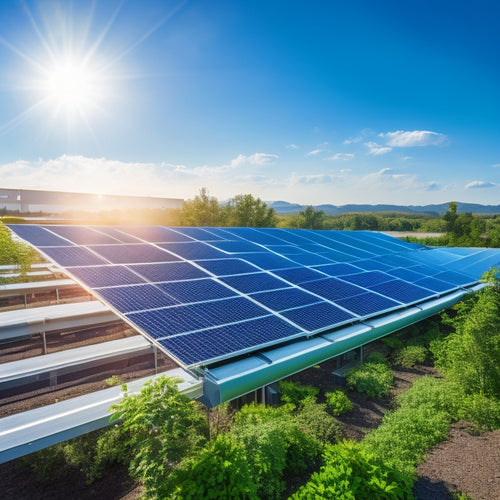
What Are the 7 Key Factors Affecting Solar Panel Roof Price
Share
You'll find that the cost of a solar panel roof is influenced by seven key factors. These include the system's size and complexity, which affect the number of panels and labor required, as well as the panel's quality and efficiency, which impact performance and cost. Your roof's size and material also play a role, along with the installation company's proficiency and local market conditions. Additionally, permits and inspection fees, as well as available incentives and rebate programs, can further impact the final price. Understanding how these factors intersect will help you make an informed decision - and uncover the subtleties that can make all the difference.
Key Takeaways
- System size and complexity significantly impact solar panel roof prices, with larger systems offering economies of scale but increased complexity.
- Panel quality and efficiency influence costs, with higher-efficiency panels often being more expensive but requiring fewer units.
- Roof size, material, and orientation affect the number of panels needed and installation difficulty, thereby impacting costs.
- Installation company reputation, labor costs, and expertise also influence overall pricing, with experienced companies potentially saving money through efficiency.
- Local market conditions, permits, and incentives, such as federal tax credits and state rebates, can significantly reduce or increase solar panel roof prices.
System Size and Complexity
Your solar panel roof price largely depends on the system size and complexity, which directly impact the cost of equipment, labor, and installation.
The system size, measured in watts (W), determines the number of panels required, which in turn affects the overall cost. A larger system capacity means more panels, mounting hardware, and inverters, increasing the upfront cost.
However, a larger system can also lead to economies of scale, reducing the cost per watt.
Complexity arises from design considerations such as roof size, shape, and orientation, as well as the number of electrical connections and penetrations. A more complex system requires more labor, specialized equipment, and engineering knowledge, driving up costs.
For instance, a system with multiple inverters or trackers will be more expensive than a simpler setup.
Understanding the system size and complexity is vital in determining the final cost of your solar panel roof.
Panel Quality and Efficiency
As you weigh your solar panel roof options, the quality and efficiency of the panels themselves play an essential role in determining the overall cost. The type of panel you choose can greatly impact the price of your solar panel roof.
There are three main panel types: monocrystalline, polycrystalline, and thin-film. Monocrystalline panels are the most efficient but also the most expensive, while thin-film panels are less efficient but more budget-friendly.
Efficiency ratings, typically measured in percentage, indicate how well a panel converts sunlight into electricity. Higher efficiency ratings result in more power per unit area, reducing the number of panels needed to achieve your desired energy output.
This, in turn, can lower installation costs. However, high-efficiency panels often come with a higher upfront cost. You'll need to balance the benefits of higher efficiency against the added expense.
Be sure to evaluate your energy needs, budget, and available roof space when selecting the right panel type and efficiency rating for your solar panel roof.
Roof Size and Material
The type of roof you have can greatly impact the cost of your solar panel installation. The size of your roof, in particular, plays a significant role in determining the number of solar panels you'll need, which in turn affects the overall cost. A larger roof requires more panels, increasing the cost, while a smaller roof requires fewer panels, reducing the cost.
The material of your roof is also important. For instance, roofs with asphalt shingles are easier to install on than those with metal or clay tiles, which can increase the installation cost.
Additionally, the roof's orientation and angle can affect the performance of your solar panels. A south-facing roof with a slight angle is ideal, as it receives the most sunlight throughout the day.
However, if your roof has a different orientation or is partially shaded, a shading analysis may be necessary to determine the best placement for your panels. This analysis will help identify areas of your roof that receive the most sunlight and optimize your solar panel installation.
Installation Company and Labor
Trained technicians with specialized equipment are the backbone of a successful solar panel installation, and their labor costs can greatly impact your overall bill.
You'll want to verify the installation company you choose has extensive experience in solar panel roof installations. Their installation experience directly affects labor costs, as a more efficient team will complete the job faster, reducing the number of hours billed.
Additionally, the company's labor costs can vary depending on their reputation, certifications, and the number of technicians required for the job. A reputable company with highly trained technicians may charge more per hour, but their efficiency and attention to detail can save you money in the long run.
Be wary of extremely low labor costs, as they may indicate inexperience or subpar workmanship.
When researching installation companies, ask about their labor costs, warranties, and certifications. This will give you a better understanding of what you're paying for and help you make an informed decision.
Local Market and Competition
Solar panel roof prices vary greatly depending on your location, and local market conditions play an essential role in determining the final cost.
As you shop around for solar panels, you'll notice that prices differ considerably from one region to another. This is because local demand, market trends, and the level of competition among installers influence pricing.
In areas with high local demand, prices tend to be higher due to increased competition among homeowners for a limited number of installations. Conversely, regions with lower demand may see lower prices as installers compete for a smaller customer base.
You should research local market trends to understand the going rate for solar panel roofs in your area. Additionally, be aware of the number of installers operating in your region, as a higher level of competition often drives prices down.
Permits and Inspection Fees
As you research local market trends, you'll also need to contemplate the costs associated with obtaining necessary permits and undergoing inspections.
These costs can vary depending on your location and the type of solar panel roof installation you're planning.
You'll need to comply with regulatory requirements and local codes, which can add to your overall expenses.
Here are some factors that can influence permit and inspection fees:
-
The type and number of permits required: This can range from electrical permits to building permits, and the costs can add up quickly.
-
The complexity of the installation: If your solar panel roof installation requires special accommodations or custom designs, you may need to pay more for permits and inspections.
-
The frequency and duration of inspections: The more frequent or lengthy the inspections, the higher the costs.
- The fees charged by local authorities: These can vary widely depending on your location and the specific agencies involved.
Keep in mind that these costs are typically a small fraction of the overall solar panel roof price, but they're still important to factor into your budget.
Incentives and Rebate Programs
While traversing the complex terrain of solar panel roof prices, you'll likely encounter incentives and rebate programs that can considerably offset your costs. These programs can markedly reduce the upfront cost of installing solar panels, making them a more viable option for homeowners.
| Incentive Type | Benefit | Eligibility |
|---|---|---|
| Federal Incentives | 26% tax credit on total system cost | Residential and commercial properties |
| State Rebates | Varies by state, up to $2.50 per watt | Residential and commercial properties, program-dependent |
| Tax Credits | 26% tax credit on total system cost | Residential and commercial properties |
| Financing Options | Lower monthly payments, 0% interest rates | Residential properties, credit-dependent |
When exploring these incentives, consider the program eligibility, application process, and potential energy savings. Additionally, factor in the environmental benefits of switching to solar power. By taking advantage of these incentives, you can markedly reduce the cost of your solar panel roof, making it a more affordable and attractive option.
Frequently Asked Questions
Can Solar Panels Be Installed on a Metal Roof?
You can install solar panels on a metal roof, but you'll need to contemplate the metal roof advantages, such as durability, and the installation challenges, like ensuring a secure attachment and avoiding damage to the roof's coating, before proceeding.
Are There Any Solar Panels Specifically Designed for Hot Climates?
You're drowning in a sea of options, but fear not! Yes, there are solar panels specifically designed for hot climates, boasting superior solar efficiency and heat resistance, ensuring maximum energy output even in scorching temperatures.
Can I Install Solar Panels Myself to Save Money?
You're considering a DIY installation to reap cost savings, but be aware that improper mounting, electrical misconnections, and warranty voidance can lead to safety risks, reduced efficiency, and financial losses, outweighing potential DIY installation cost savings.
Are There Any Solar Panels With a 30-Year Warranty?
You'll find top-tier solar panels offering 30-year warranties, providing unparalleled longevity benefits; when comparing warranties, consider brands like Panasonic, Tesla, and SunPower, which back their products with extensive guarantees for your peace of mind and long-term energy independence.
Can Solar Panels Be Integrated Into a Roof's Architectural Design?
You'll be interested to know that 70% of homeowners consider solar panels a desirable feature, and yes, you can integrate them into your roof's structural design, ensuring aesthetic considerations and design compatibility, which is essential for a seamless installation.
Conclusion
As you weigh the costs of going solar, remember that the devil is in the details. The 7 key factors affecting solar panel roof price - system size and complexity, panel quality and efficiency, roof size and material, installation company and labor, local market and competition, permits and inspection fees, and incentives and rebate programs - all intersect like threads in a fabric, influencing the final price tag. By understanding these factors, you'll be better equipped to steer through the solar market and make an informed decision that shines bright for your wallet.
Related Posts
-

Energy-Efficient Lighting Solutions for Sustainable Buildings
For sustainable buildings, energy-efficient lighting solutions, like LEDs, offer multiple benefits. These bulbs last ...
-

How to Reduce Home Energy Bills
To reduce your home energy bills, start by investing in energy-efficient appliances and upgrading your insulation. Lo...
-

Solar Energy Efficiency Improvements for Businesses
Improving solar energy efficiency for your business can lead to considerable cost savings and enhance your sustainabi...


